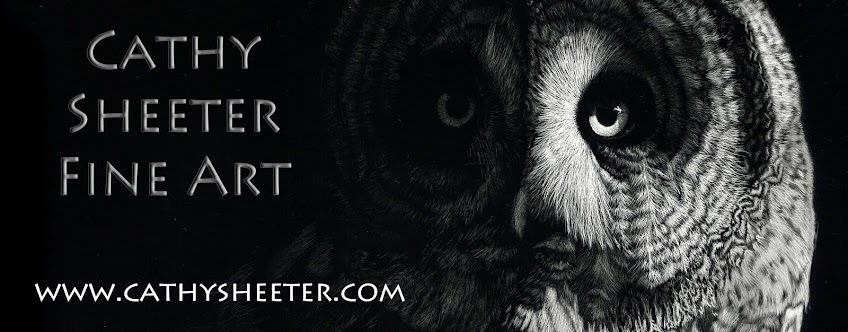Every piece of artwork has a flow to it. It has a way that the average person sees each item within the image or how our eye travels the path of the artwork. While there will be some minor deviation based on individuality, most people’s eyes tend to mostly travel a similar path.
Through human nature certain things draw our eyes more than others. Some of the things that tend to draw our eye are:
-Strong contrast of light and dark (Bright whites, dark shadows)
- Bright colors
- Hard edges
- Lines in general, but also lines that lead in or out of an image (these lines can be anything from a branch or piece of grass, to a cloud or rock formation)- Warm colors in a cool image
- Cool colors in a warm image
Some artists are masters of leading the eye! One of my favorites is when they hide something in plain sight! Here are a couple of examples:
 |
| Copyright Bev Doolittle - "Doubled Back" |
The first thing that the majority of people will notice in this piece by Bev Doolittle titled “Doubled Back” is the strong contrast and hard edges of the bear tracks lead us right up the line of snow to the rock formation that is shaped like a bear. But then the warm colors of the thicket brings us back to other aspects of the image to notice… surprise! There is a ‘real’ bear in the willows! The similar values between the bear and the thicket keep us from noticing it any sooner, just as the artist intended!
 |
| Copyright Robert Bateman - "Winter Reflection Wolf" |
Robert Bateman is another one that knows just how your eye travels and uses this for impact. “Winter Reflection Wolf” plays a similar trick on our eyes. The hard lines and strong values of the water with the snow lead our eye there first. We follow it and it only leads us out of the image. But me know there is more so we come back and look harder. Next the lines of the icicles catch my eye, as do the lines leading down through the rocks. Still not all that interesting. Finally my eye catches the one rock with puffy snow pointing upwards and suddenly… bam! There’s the wolf! You wonder how you didn’t see it before, but the wolf is hidden on purpose, by using very minimal contrast and letting him merge just enough with the background that he is obscured.
Probably one of the best known Bateman images is this one:
 |
| Robert Bateman - "Midnight - Black Wolf" |
Why do you think it is so popular? Not only a popular subject matter, but masterfully crafted by the artist as well!
Of course even when you are not hiding something within the image composition is paramount! How can you keep the viewers eye traveling in a manner that brings attention to the most important aspects of the work and keeps bringing them back to it?
 |
| Carl Brenders - "One to One" |
Carl Brenders is not known for hiding his critters, but he still uses strong compositions to keep the viewers eye moving, but always coming back to what is most important. Many of his works have a circular flow. His well known image titled “One to One” leads our eye in a perfect circle from the wolf to the rocks, which circle back around to the wolf. Even the lighter color twig brings us back to the wolf. Simple and effective.
 |
| Daniel smith - "Sun Struck" |
How do the warm colors and light lead your work in this work by Daniel Smith?
As you become more aware of what you eye is doing within a work you might want to stop and think about WHY is it traveling the way that it is. Hard lines, contrast, bright colors? Just as good composition can make an image, poor composition can ruin one just as easily. If all the elements lead out of the image rather than in toward the main subject we tend to quickly loose interest in viewing it. If the work is too busy with no center of interest that too makes us want to move on. If your strongest contrast falls on things that are not significant to the work our eye will go there, rather than to what you are trying to show us. Composition, truly can make you want to leave an image as quickly as you entered it, or it can make you want to sit and stay for a while.
So next time think about your scene and how the viewers eye will travel through your work… Like what direction your grasses are pointing (do they all point out of the frame taking your eye out too). What about branches on a tree. How does your eye flow through them? Does it bring you back around to a location you want it to or again take you out of the image? How does the light affect the travel of your eye? Is there something you can add (or take away) that will improve how smoothly your eye travels through your work? Do you have many strong lines leading out of the image? If you want something hidden is it effective?
After all you are the master and commander of all who view your work!
While I don't consider myself a master at compositions like these artists I posted, I do certainly give them a moderate amount of time and though. How does your eye travel through this new version of "Edge of Darkness". How does the body shape of the wolf and my choice of grasses and values in the background trees help to lead your eye in a circle?




















